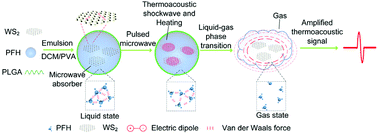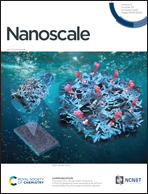A stimulated liquid–gas phase transition nanoprobe dedicated to enhance the microwave thermoacoustic imaging contrast of breast tumors†
Abstract
Microwave-induced thermoacoustic imaging (MTAI), combining the advantages of the high contrast of microwave imaging and the high resolution of ultrasonic imaging, is a potential candidate for breast tumor detection. MTAI probes have been used to extend thermoacoustic imaging to molecular imaging. However, due to the high content of water molecules in tissues, the thermoelastic expansion-based probes used in conventional MTAI are not capable of adequate enhancement. Herein, an MTAI nanoprobe for amplification of thermoacoustic (TA) signals by the stimulated liquid–gas phase transition mechanism has been developed, providing significantly higher signal amplitude than that from the conventional mechanism of thermoelastic expansion. The nanoprobe consists of liquid perfluorohexane (PFH) and tungsten disulfide (WS2) nanoparticles rich in defect electric dipoles. When irradiated with pulsed microwaves, the defect electric dipoles in WS2 were repeatedly polarized by gigahertz. This results in localized transient heating and an acoustic shockwave, which destroys the van der Waals forces between PFH molecules. Ultimately, liquid PFH droplets undergo a liquid–gas phase transition, generating dramatically enhanced TA signals. The practical feasibility was tested in vitro and in a breast tumor animal model. The results show that the proposed nanoprobe can greatly improve the contrast of tumor imaging. It will be a new generation probe for MTAI.

- This article is part of the themed collection: 2020 Nanoscale HOT Article Collection


 Please wait while we load your content...
Please wait while we load your content...